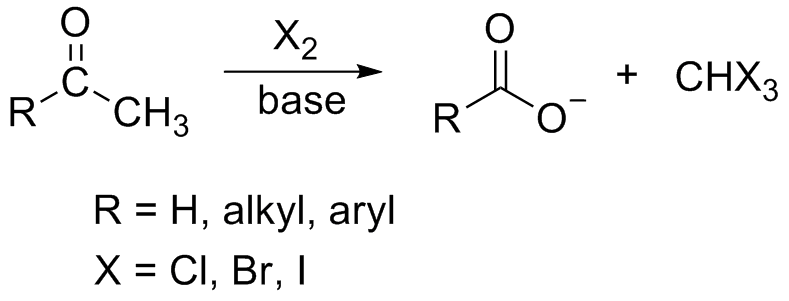
What is the test to differentiate between pentan-2-one and pentan-3-one.
A.Iodoform test
B.Benedict’s test
C.Fehling’s test
D.Aldol condensation
Answer
481.5k+ views
Hint: To answer this question, you should recall the test to differentiate between carbonyl compounds at second position and at other intermediate positions. This test involves the reaction of iodine, a base and a methyl ketone gives a yellow precipitate.
Complete step by step answer:
When Iodine and sodium hydroxide are added to a chemical species containing either a methyl ketone or secondary alcohol with a methyl group in the alpha position, a pale yellow precipitate i.e. iodoform or triiodomethane is formed.
The general haloform reaction of methyl ketones can be represented as:

In the reaction, in the first step, the hydroxide ion removes the acidic alpha hydrogen from the ketone resulting in the formation of an enolate ion. This newly formed enolate anion further displaces an iodide ion from the iodine molecule. This process repeats and ultimately the hydroxide ion forms a bond with the carbonyl carbon.
The final result is the reformation of the carbonyl group and the elimination of the
Hence, the correct answer to this question is option A.
Note:
If an aldehyde gives a positive iodoform test, then it must be acetaldehyde since it is the only aldehyde with a
First, the Hydroxide ion removes acidic alpha hydrogen. This results in the formation of an enolate ion. The enolate anion then goes on to displace an iodide ion from the iodine molecule. This process repeats twice to give
Now, a hydroxide ion forms a bond with the carbonyl carbon. This leads to the reformation of the carbonyl group and the elimination of the
Complete step by step answer:
When Iodine and sodium hydroxide are added to a chemical species containing either a methyl ketone or secondary alcohol with a methyl group in the alpha position, a pale yellow precipitate i.e. iodoform or triiodomethane is formed.
The general haloform reaction of methyl ketones can be represented as:

In the reaction, in the first step, the hydroxide ion removes the acidic alpha hydrogen from the ketone resulting in the formation of an enolate ion. This newly formed enolate anion further displaces an iodide ion from the iodine molecule. This process repeats and ultimately the hydroxide ion forms a bond with the carbonyl carbon.
The final result is the reformation of the carbonyl group and the elimination of the
Hence, the correct answer to this question is option A.
Note:
If an aldehyde gives a positive iodoform test, then it must be acetaldehyde since it is the only aldehyde with a
First, the Hydroxide ion removes acidic alpha hydrogen. This results in the formation of an enolate ion. The enolate anion then goes on to displace an iodide ion from the iodine molecule. This process repeats twice to give
Now, a hydroxide ion forms a bond with the carbonyl carbon. This leads to the reformation of the carbonyl group and the elimination of the
Latest Vedantu courses for you
Grade 9 | CBSE | SCHOOL | English
Vedantu 9 CBSE Pro Course - (2025-26)
School Full course for CBSE students
₹37,300 per year
Recently Updated Pages
Master Class 9 General Knowledge: Engaging Questions & Answers for Success

Master Class 9 English: Engaging Questions & Answers for Success

Master Class 9 Science: Engaging Questions & Answers for Success

Master Class 9 Social Science: Engaging Questions & Answers for Success

Master Class 9 Maths: Engaging Questions & Answers for Success

Class 9 Question and Answer - Your Ultimate Solutions Guide

Trending doubts
Give 10 examples of unisexual and bisexual flowers

Draw a labelled sketch of the human eye class 12 physics CBSE

Differentiate between homogeneous and heterogeneous class 12 chemistry CBSE

Differentiate between insitu conservation and exsitu class 12 biology CBSE

What are the major means of transport Explain each class 12 social science CBSE

Draw a diagram of a flower and name the parts class 12 biology ICSE




